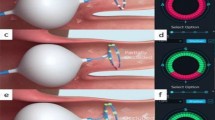Abstract
Background
A new catheter-based 3D dielectric imaging modality to guide electrophysiology ablation procedures that does not require contact or X-ray to image and offers new benefits for cryoablation procedures.
Case presentation
A 51-year-old male with paroxysmal atrial fibrillation was admitted to our hospital for atrial fibrillation ablation that was performed using cryoballoon fourth generation combined with a novel wide-band dielectric imaging system [KODEX-EPD (EPD Solutions, a Philips company)].
Conclusions
This system allowed to visualize left common pulmonary vein before balloon positioning and then confirmed by pulmonary vein angiography.
Similar content being viewed by others
Background
Standard pulmonary vein (PV) anatomy (two left-sided and two right-sided PVs with separated ostia) is present in 70% of cases. In 30% patients, abnormal anatomy [left common pulmonary vein (LCPV) or accessory PV] is recorded. Patients with LCPV have significantly reduced AF-free survival after ablation with cryoballoon, despite similar acutely successful PV isolations (PVIs) [1]. Anatomic map of the left atrium using KODEX-EPD (EPD Solutions, a Philips company) [2,3,4] shows the potential to visualize abnormal PV anatomy and guide correct PV ostium occlusion.
Case presentation
A 51-year-old Caucasian male with hypertension was admitted to our hospital for ablation of paroxysmal atrial fibrillation refractory to antiarrhythmic drugs.
After a single trans-septal puncture, the left atrium (LA) imaging was performed using a decapolar circular mapping catheter (Achieve Advance 25, Medtronic) and KODEX-EPD (EPD Solutions, a Philips company) system. During LA reconstruction, a LCPV was rapidly identified (Fig. 1). Achieve was placed within the LCPV, the cryoballoon (Arctic Front Advance Pro, 28 mm diameter, Medtronic) was inflated, and baseline occlusion tool software data were collected. Then, cryoballoon was positioned, occlusion was verified by occlusion tool software tool [KODEX-EPD (EPD Solutions, a Philips company)], and PV angiography was performed showing the complete occlusion of LCPV (Fig. 2). Cryoenergy was delivered reaching the following parameters: time to isolation was 26 s, and max temperature was − 53 °C with a freeze-cycle duration of 180 s. Achieve was positioned into every single branch of LCPV to check the complete electrical isolation. As previously described [5], a single cryoenergy delivery was useful for complete isolation of a long and tight LCPV (Fig. 3). Similarly, right superior PV (RSPV) and right inferior PV (RIPV) were isolated using occlusion tool software tool information.
Discussion and conclusions
The imaging system integrated to cryotechnology allows to visualize abnormal anatomies (Fig. 4) before angiography, avoiding the search for a separate ostium, and, thanks to the Occlusion Tool software, allows to position the cryoballoon correctly by reducing the amounts of time rays exposure and contrast.
Availability of supporting data
Not applicable.
References
Beiert T, et al. Outcome in patients with left common pulmonary vein after cryoablation with second-generation cryoballoon. Pacing Clin Electrophysiol. 2018;41(1):22–7.
Romanov A, et al. High-resolution, real-time, and nonfluoroscopic 3-dimensional cardiac imaging and catheter navigation in humans using a novel dielectric-based system. Heart Rhythm. 2019;16(12):1883–9.
Maurer T, et al. High-resolution imaging of LA anatomy using a novel wide-band dielectric mapping system: first clinical experience. JACC Clin Electrophysiol. 2019;5:1344–54.
Nicholls M. KODEX-EPD mapping for AF ablation: cardiologists in the UK are trialling a new system they believe could be a game-changer in the treatment of Atrial Fibrillation (AF). Euro Heart J. 2019;40(36):3003–5. https://doi.org/10.1093/eurheartj/ehz647.
Heeger C-H, et al. Acute efficacy, safety, and long-term clinical outcomes using the second-generation cryoballoon for pulmonary vein isolation in patients with a left common pulmonary vein: a multicenter study. Heart Rhythm. 2017;14(8):1111–8.
Acknowledgements
Not applicable.
Funding
No external funding was obtained for this project.
Author information
Authors and Affiliations
Contributions
All authors gave equal contribution. All authors read and approved the final manuscript.
Corresponding author
Ethics declarations
Ethical approval and consent to participate
Not applicable.
Consent for publication
Not applicable.
Competing interests
The authors declare that they have no competing interests.
Additional information
Publisher's Note
Springer Nature remains neutral with regard to jurisdictional claims in published maps and institutional affiliations.
Rights and permissions
Open Access This article is licensed under a Creative Commons Attribution 4.0 International License, which permits use, sharing, adaptation, distribution and reproduction in any medium or format, as long as you give appropriate credit to the original author(s) and the source, provide a link to the Creative Commons licence, and indicate if changes were made. The images or other third party material in this article are included in the article's Creative Commons licence, unless indicated otherwise in a credit line to the material. If material is not included in the article's Creative Commons licence and your intended use is not permitted by statutory regulation or exceeds the permitted use, you will need to obtain permission directly from the copyright holder. To view a copy of this licence, visit http://creativecommons.org/licenses/by/4.0/.
About this article
Cite this article
Schillaci, V., Stabile, G., Shopova, G. et al. Utility of a new imaging system for displaying complex anatomy during AF ablation with cryoenergy. Int J Arrhythm 21, 11 (2020). https://doi.org/10.1186/s42444-020-00019-3
Received:
Accepted:
Published:
DOI: https://doi.org/10.1186/s42444-020-00019-3








